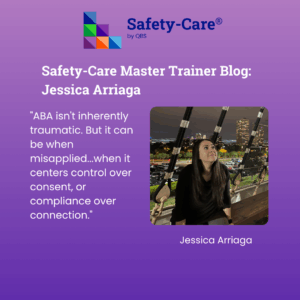Rethinking ABA Through a Trauma-Informed Lens
Applied Behavior Analysis (ABA) has long been a go-to therapeutic approach for individuals with developmental disabilities, especially autism. At its best, it supports communication, daily living, independence, and safety. The field has excelled at disseminating in other areas as well, such as health, sports, fitness, and organizational behavioral management to name a few.
For many individuals, ABA has made a life-changing difference. But it’s time to be real: for others, ABA has been a source of distress…even trauma. This is not an attack on the science; in fact, I LOVE the science. It’s a critique of how it’s sometimes applied. More and more self-advocates, caregivers, and ethical professionals are speaking up about how outdated or rigid ABA practices (particularly when implemented without a trauma-informed, person-centered lens) can cause harm.
Let’s unpack five core areas where I believe ABA has historically contributed to trauma, then highlight how practitioners are reshaping the future of behavior support to prioritize dignity, autonomy, and emotional well-being.
Overemphasis on Compliance
Classic ABA models often center on compliance with adult demands: prompt-following, sitting still, hands quiet. But is blind compliance really the goal? Dr. Alfie Kohn (2005) warns that compliance training fosters power imbalances and strips people of agency. This is especially risky when individuals have limited communication skills, and their “noncompliance” might be their only way to say “no.”
Dr. Hanley’s approach flips this dynamic on its head. His PFA and SBT model (Practical Functional Assessment and Skills Based Treatment) begins with gaining assent and identifying contextual conditions that produce safe, happy, and engaged behavior, not just external compliance. If a person isn’t willingly participating, the session stops. Period. This isn’t just more ethical, it’s more effective. “Compliance shouldn’t come at the cost of consent.” – @NeurodivergentRebel
Suppression of Natural Behaviors
Behaviors like rocking, flapping, scripting, and pacing (often labeled as “disruptive” or “nonfunctional”) are frequently targeted for reduction. But many of these behaviors are self-regulatory, calming, and deeply personal. Suppressing them without truly understanding their function can spike anxiety and lead to escalation. Kapp et al. (2019) found that stimming supports emotional regulation and well-being. Yet older ABA protocols still treat it like a problem to put on extinction.
Ignoring Emotional Distress
Some legacy ABA strategies outright ignore visible distress, such as planned ignoring, escape extinction, and withholding preferred items while a child screams – teaching individuals to “tolerate” distress without addressing why it’s happening.
These methods can be non-supportive and don’t truly incorporate an individual’s feelings.
Kupferstein (2018) found links between these practices and PTSD-like symptoms in autistic adults. Practitioners should approach shaping toleration only after the person is calm, safe, and trusting, not while they’re upset and feel unsafe. Trauma-informed ABA means you respond to distress—not dismiss or ignore it.
Excessive Intensity
40-hour weeks, table time, mass trials…
For young children or individuals with complex trauma histories, this kind of intense treatment can be damaging, not developmental. The American Academy of Pediatrics recommends play, rest, and social-emotional learning, not just nonstop instruction. And frankly, burnout is real, for kids, families, and staff. ABA should focus on context over hours. Practitioners should build strong, safe relationships and naturally reinforcing skill use. Fewer hours, better outcomes!
Rigid, One-Size-Fits-All Protocols
When ABA becomes a checklist of programs and targets, it misses the point. Real support should meet the individual’s communication style, culture, trauma history, and goals. Too many people still experience ABA as a tool to make them appear “normal”, not to help them thrive as themselves.
Programs like Dr. Hanley’s PFA/SBT model approach is built on personalization. It starts with an open-ended interview to understand what makes the person feel safe, happy, and engaged. Only then are skills introduced at a pace and in a manner that builds trust, not tension.
Curriculums like QBS’s Safety-Care focus on supporting individuals rather than controlling them. This person-centered approach ensures that support is tailored and responsive to the emotional, environmental, and contextual factors that influence behavior.
Lets talk about how we can move toward trauma-informed ABA!
The field is changing. We’re seeing a real shift away from power-and-control models toward trauma-informed, neurodiversity-affirming, and person-centered ABA.
Key principles include:
- Assent and Consent: If the individual isn’t willing, we stop.
- Respect for Autonomy: Everyone has the right to say “no.”
- Emotional Safety: We don’t ignore distress; we respond to it.
- Meaningful Goals: We’re not here to make people “normal.” We’re here to help them thrive.
- Collaboration: Families, caregivers, and individuals shape the plan together.
Why do I mention Safety-Care and continue to be passionate about this curriculum and company? Because it is a model of respectful, trauma-informed support. QBS’s mission and the Safety-Care curriculum is aligned with this evolution. It teaches staff and families to:
- Recognize signs of distress early
- Use de-escalation and emotional regulation techniques
- Respond with the least-restrictive, most respectful methods possible
Safety-Care shares philosophical DNA with Hanley’s work: no coercion, less control, more connection.
My Last Two Cents…
ABA isn’t inherently traumatic. But it can be when misapplied…when it centers control over consent, or compliance over connection.
People are not a set of behaviors to “fix.” They’re humans with histories, needs, and preferences. Every part of their care, including behavior support, must reflect that. One of my favorite sentences in Safety-Care’s core curriculum is “It is our job to support, not to control.” Dr. Greg Hanley’s PFA/SBT model, QBS’s Safety-Care training, and trauma-informed guidelines from organizations like CASP and BHCOE are proof that ABA can evolve. That it is evolving.
Let’s be clear: none of this dismisses the dedication of practitioners who’ve helped countless individuals. But the future of ABA must prioritize dignity, emotional safety, and autonomy.
If your behavior plan doesn’t reflect those values, it’s time to change it. Therapy should never be about forcing someone to fit in. It should be about helping them flourish.
References
Council of Autism Service Providers (CASP). (2021). Organizational Guidelines for the Practice of Applied Behavior Analysis. Retrieved from https://casproviders.org/
Hanley, G. P., Jin, C. S., Vanselow, N. R., & Hanratty, L. A. (2014). Producing meaningful improvements in problem behavior of children with autism via synthesized analyses and treatments. Journal of Applied Behavior Analysis, 47(1), 16–36. https://doi.org/10.1002/jaba.106
Hanley, G. P., Vanselow, N. R., & Iwata, B. A. (2022). Practical functional assessment and skill-based treatment: A compassionate and trauma-assumed approach to problem behavior. Behavior Analysis in Practice, 15, 489–501. https://doi.org/10.1007/s40617-021-00635-y
Hirsh-Pasek, K., Golinkoff, R. M., Berk, L. E., & Singer, D. G. (2009). A Mandate for Playful Learning in Preschool: Applying the Scientific Evidence. Oxford University Press.
Kapp, S. K., Steward, R., Crane, L., Elliott, D., Elphick, C., Pellicano, E., & Russell, G. (2019). “People should be allowed to do what they like”: Autistic adults’ views and experiences of stimming. Autism, 23(7), 1782–1792. https://doi.org/10.1177/1362361319829628
Kohn, A. (2005). Unconditional Parenting: Moving from Rewards and Punishments to Love and Reason. Atria Books.
Kupferstein, H. (2018). Evidence of increased PTSD symptoms in autistics exposed to applied behavior analysis. Advances in Autism, 4(1), 19–29. https://doi.org/10.1108/AIA-08-2017-0016
QBS, Inc. (n.d.). Safety-Care® Behavioral Safety Training. Retrieved from https://qbs.com/
Sequenzia, A. (2015). Autistic, Non-Speaking and Proud. Retrieved from https://autisticsspeakingday.blogspot.com/2015/11/autistic-non-speaking-and-proud.html
Behavioral Health Center of Excellence (BHCOE). (n.d.). Accreditation Standards and Resources. Retrieved from https://www.bhcoe.org/
About the Author
Jessica Arriaga is a Board Certified and Licensed Behavior Analyst with over 15 years of experience in applied behavior analysis, speech pathology, and education. She received her undergraduate degree at Northern Illinois University and her graduate degree at Aurora University. She has worked in schools, clinics, homes, residential facilities, developmental training centers, and job sites providing behavior analytic services to individuals on the autism spectrum. She has been a Master Trainer with QBS since 2021.

 By using our site, you consent to our use of cookies to enhance functionality and analyze site performance.
By using our site, you consent to our use of cookies to enhance functionality and analyze site performance.